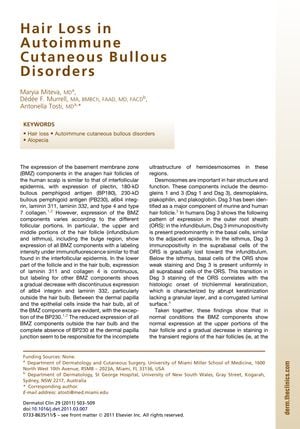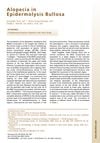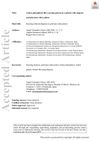Hair Loss in Autoimmune Cutaneous Bullous Disorders
May 2011
in “
Dermatologic Clinics
”
autoimmune cutaneous bullous disorders basement membrane zone desmosomes pemphigus bullous pemphigoid erosive cicatricial alopecia Mucous Membrane Pemphigoid cicatricial alopecia Epidermolysis Bullosa Acquisita scarring alopecia Bullous Systemic Lupus Erythematosus SLE Dermatitis herpetiformis alopecia areata immune privilege autoimmune response

TLDR Hair loss in autoimmune blistering skin diseases varies and may regrow with disease control.
The document from 2011 examines the relationship between hair loss and autoimmune cutaneous bullous disorders, focusing on the expression of basement membrane zone components and desmosomes in hair follicles. It finds that hair loss is not a typical feature of pemphigus in humans, although it is common in animal models, and when it does occur in humans, it can present in various forms with the potential for complete regrowth once the disease is controlled. The document also reports on hair loss in other bullous disorders, noting that while no hair loss is reported in bullous pemphigoid, variants such as erosive cicatricial alopecia have been described. Mucous Membrane Pemphigoid can cause cicatricial alopecia with rare scalp involvement, Epidermolysis Bullosa Acquisita can lead to scarring alopecia, and Bullous Systemic Lupus Erythematosus may have scarring alopecia due to SLE rather than the bullous phenotype. Dermatitis herpetiformis can involve the scalp and may be associated with alopecia areata. The document concludes that hair loss in these disorders is variable and may be influenced by factors such as the immune privilege of hair follicles or the specific autoimmune response in affected individuals.



